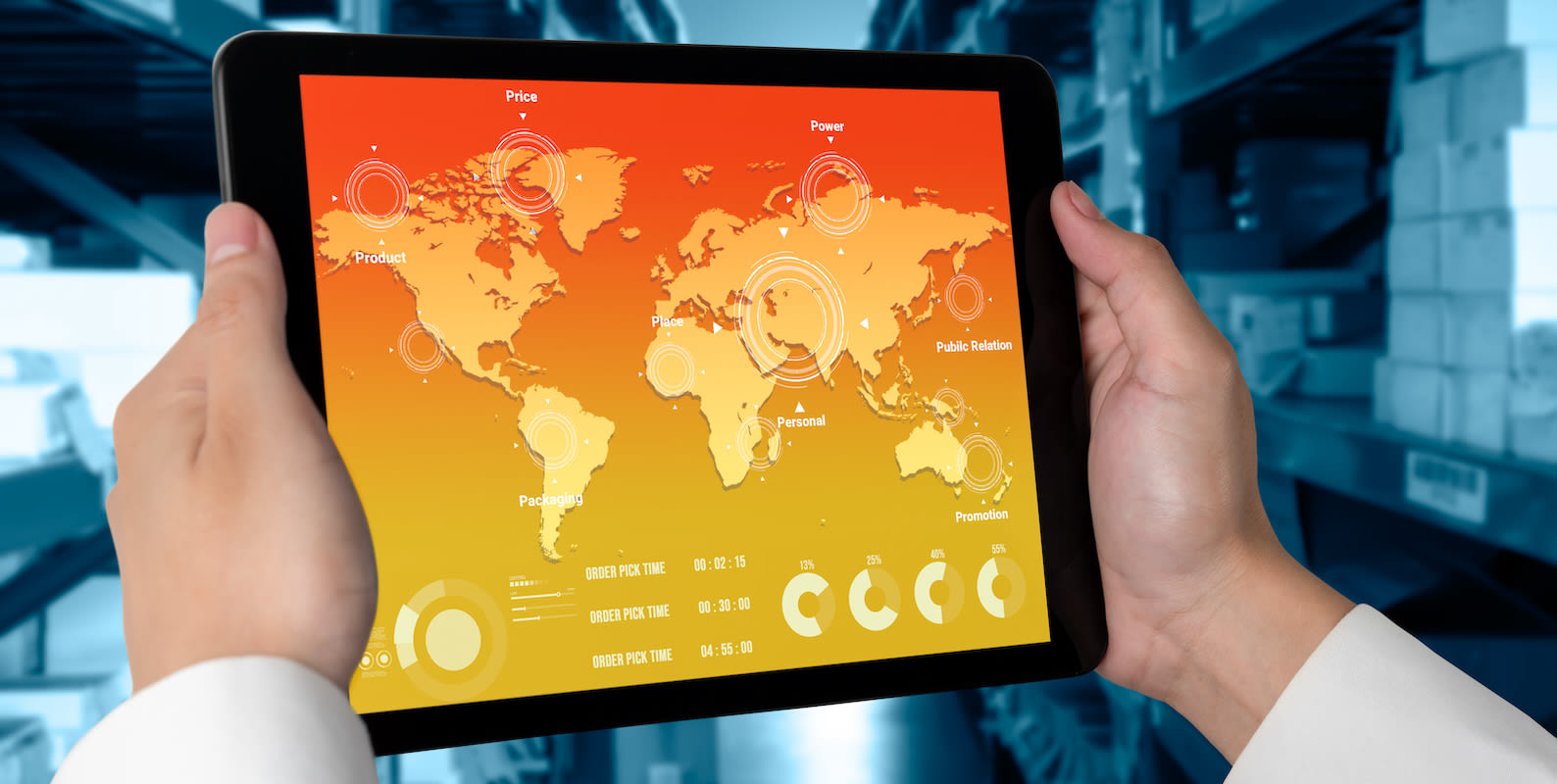
June 8, 2023
Are We There Yet? Tracking the Recovery in Global Supply Chains

Senior Editor, Flexport Research
How badly were supply chains disrupted by the pandemic, and is this all behind us? On the latter point, leading measures disagree. We review the evidence.
Supply chains are stronger than ever, or there is the least “pressure” on them than there has been in the last 25 years. That according to the latest Global Supply Chain Pressure Index (GSCPI) from the NY Federal Reserve, published on June 6th and covering the month of May. The May reading was -1.71, the number of standard deviations from the historical average. The figure peaked at +4.31 in December 2021, indicating the most intense pressure across the index components, such as new orders, inventories and transport costs.

The dispute here is not with the trend this approach finds, which is fairly clear: supply chains have been getting better. Far better than they were, in fact, and without question. The issue, rather, is whether we can really conclude they are functioning as they did prior to the pandemic.
That is disputable.
Capturing the complexity of supply chains in a single, composite measure like the GSCPI is a difficult task. Worse still, are scattershot selections of mostly U.S.-centric indicators – as some use as evidence of normalcy – that do not help in clarifying matters.
Other measures employing this gauge of supply chain health have recently made more modest claims that they are just broadly back to normal.
So how can one reconcile these differences? One way is to look behind the headline numbers to components. Another is to see whether the conclusions are backed by multiple sources of evidence.
Time on the Tides
To sort things out, we can start with time, the inclusion of which as a sub-component in the GSCPI is opaque; it appears to favor a greater reliance on price signals (though it is hard to know for certain without a publicly-available and comprehensive methodology document).
Eighty-percent or more of global trade – raw materials, intermediate goods and finished products – is transported by ocean. If supply chains are indeed back to normal, ocean transit times should have returned to the pre-pandemic levels. Flexport’s Ocean Timeless Indicator (OTI), a broad measure of the stress on global ocean shipping that tracks cargo ready dates to origin port departures on the two of the busiest trade lanes – Transpacific Eastbound (TPEB) and Far East Westbound (FEWB) – suggests we are not there yet.

From April 2019 to the end of December that year, the average number of transit days was 54 on the FEWB lane and 46 on TPEB. At the height of the pandemic, when supply chains were most disrupted, the weekly average reached 122 days on FEWB in the second week of April 2022 and stayed at 113 days for a two week stretch at the end of January 2022 on TPEB. As is clear in the chart above, since those peaks the shipping times have fallen, rarely in a straight line but clearly on a strong downward trend.
Yet, the times remain above 2019 levels and by a considerable margin. As of the end of May, the latest data available, FEWB times are at 72 days and TPEB at 61. Or more than two weeks longer in both cases.
The reasons why this might be are important to understand.
Foremost among them is what has been happening on the seas. Intermediate stages in the OTI are showing three factors involved here, with a fourth that it does not capture directly. The first is the number of ‘blank sailings’ These are ports skipped on a scheduled journey or, rarer, journeys canceled altogether. Blank sailings have fallen but remain elevated from pre-pandemic norms. Second, the number of stops carriers are making between origin and final destination ports has actually increased in recent months, even if they are not as high as they were in Spring 2022. And third, the length of those stops – transshipment stops – are still on average days longer than they were in 2019.
The fourth factor is that the carriers are reportedly slowing their ships. Explanations vary, but include a mix of weakening demand at a time of overcapacity, higher fuels and/or the shift to more sustainable fuels, and environmental regulations.
Material constraints
If supply chains really are functioning historically well, we would expect companies to have relatively few concerns about the availability of supply. Quarterly surveys of manufacturers in the Euro area, the U.S., and Canada, however, show that bottlenecks have been improving but remain a concern.
Asked about plant capacity utilization, the share of managers in the Euro area reporting shortages of material and equipment as factors limiting production fell to 27.8 in Q2 this year, down more than 10 points from the previous quarter and almost by half from the high of 54.3 hit in Q3 2022. Yet that is still more than two-and-a-half times the quarterly average of 11.5 in 2019.

The U.S. Census Bureau’s Quarterly Survey of Plant Capacity Utilization, though not yet updated for the first quarter of 2023, was also trending upward in the last two quarters of 2022 on the response rate to “insufficient supply of materials.” It too ended the year three-times above the 2019 average, however.
Finally, The Bank of Canada’s Business Outlook Survey, which is updated through Q1 of this year, asked respondents if they were facing “supply chain bottlenecks,” a variation on the more specific Euro area and U.S. questions about shortages. There had been a sharp improvement in Q4 of last year, as shown in the chart, only for the more recent results to show a slight weakening. The Q2 results for this year will be published next month.
Looking back, Europe is recovering from a deeper trough, having faced not only the Covid-related disruptions, but the fallout from the conflict in Ukraine, which affected energy supply and prices, as well as the food and agriculture and automotive sectors.
Manufacturers in the U.S. and Canada were more – although not entirely – insulated from the conflict.
Nevertheless, on current trend it looks as though there could be at least two to four more quarters to go before a return to pre-pandemic levels in material supply (and assuming Canada’s Q1 reading was just a pause). Why is it taking so long, considering the otherwise favorable conditions?
One obvious answer is that there is a surfeit of uncertainty. But it’s warranted here. As we’ve noted in recent Weekly Economic Reports and in more than a few Commentaries, the world is awash with conflicting data – indicators that once moved in unison are diverging, divergent indicators are converging, trends expected to subside have persisted. We are in uncharted territory in almost every respect, supply chains included.
This is compounded by new and proposed policies aimed specifically at materials, sustainability and supply chains. To the extent they are already in effect, or will be soon, these policies are inevitably going to complicate procurement for manufacturers in the near to medium-term and maybe even permanently. There’s a strong argument that the dotted red-line in the chart above – the three country composite average for 2019 – is actually a bar that needs to be raised.
Conclusion
All three measures of supply-chain health above show a parabolic-shaped recovery from the pandemic. In two of the measures, the parabolas are truncated, stopping short of touching the 2019 baseline that would mark a full recovery. This is not to say supply chains won’t get back to that point. They might; they’re certainly moving in the right direction. Or it might be that, after all that transpired over the past three-plus years, the definition of what constitutes a recovery should change.
Disclaimer: The contents of this report are made available for informational purposes only and should not be relied upon for any legal, business, or financial decisions. Flexport does not guarantee, represent, or warrant any of the contents of this report because they are based on our current beliefs, expectations, and assumptions, about which there can be no assurance due to various anticipated and unanticipated events that may occur. This report has been prepared to the best of our knowledge and research; however, the information presented herein may not reflect the most current regulatory or industry developments. Neither Flexport nor its advisors or affiliates shall be liable for any losses that arise in any way due to the reliance on the contents contained in this report.
About the Author

Senior Editor, Flexport Research




